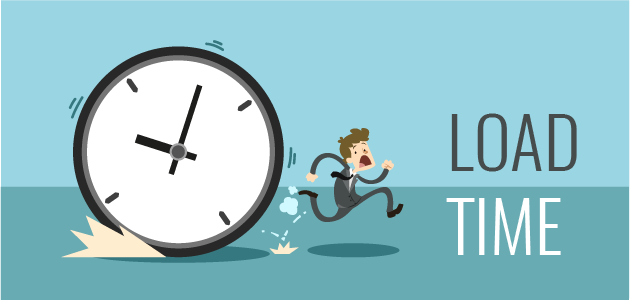9 Easy Ways to Make WordPress Lightning Fast

WordPress is the most popular CMS out there. But, there are a lot of things slowing it down.
Maybe you’ve already noticed this on your own site. With heavy plugins, dense themes and millions of users, WordPress isn’t always the speediest platform.

The bad news is that a slow website can cause all sorts of problems. First of all, it’s a poor first impression. You want your visitors to associate your site with professionalism and speed – not a slow load time.
Some studies have shown that slow websites actually drive people away and kill your conversions. If it’s really slow, Google may even drop your page rank.
The good news is that there are plenty of things we can do to speed things up.
1. Invest in a Fast Web Host
Web hosts come in all shapes and sizes, but most people make a choice based on cost. Problem is, the cheapest is rarely the best!
A cheap web host often means a ‘shared’ server. In other words, you’re sharing space and resources with countless other websites across the world. If one website on your shared server gets a flood of visitors, it might impact the speed of yours.
If you’re curious about how fast your web host is currently performing, check out this server speed checker tool. This will tell you how fast your web host server response time is.
Google recommends a server speed of less than 200ms, so if your server is slower than that, time to rethink your web host.
2. Choose a Lightweight Theme
If your web host is the first place to look for extra speed, your theme is the second. The great thing about WordPress is the many hundreds of themes you can choose to design your site.
 But remember, anyone can create a theme and make it available online. There’s no guarantee that the theme has been coded efficiently. Some themes are incredibly heavy and dense with unnecessary code.
But remember, anyone can create a theme and make it available online. There’s no guarantee that the theme has been coded efficiently. Some themes are incredibly heavy and dense with unnecessary code.
But, how do I know if a theme is lightweight?
The first thing to check is the file size. Anything bigger than 2MB should really be avoided. You can also run the demo site through a load-speed checker to see how quickly it responds.
3. Think Carefully About Your Plugins
It’s easy to get carried away when installing plugins. Again, there are hundreds to choose from, and they’re all useful in their own way.
But remember, every plugin has to be dragged in and loaded up. That means every plugin adds a few milliseconds to your load speed. And, if they’re heavily coded or inefficient, they’ll take even longer.
Think carefully about which plugins your site actually needs. Which ones could you get rid of?
4. Shrink Your Images
We all want our photos and images to look fantastic online. But that doesn’t mean you need to use the full file size. Again, the bigger and heavier your images, the longer they’ll take to load.
 In general, WordPress themes and browsers are rarely more than 1,000 pixels wide. So if your images are larger than 1,000px wide, you can easily shrink them without losing quality.
In general, WordPress themes and browsers are rarely more than 1,000 pixels wide. So if your images are larger than 1,000px wide, you can easily shrink them without losing quality.
Consider the format too. JPEGs are generally lighter than PNGs because they’re compressed, so they’ll help speed things up.
5. Don’t Ignore Your Updates!
WordPress sends us tons of update requests, and it can seem annoying. But, trust me, they’re all important!
Updates are essential for keeping your themes, plugins and software secure and speedy. Each new update carries a performance boost. If you’re sitting on lots of pending updates, hit the upgrade button – it’s the easiest and quickest way to speed your website.
6. Install A Caching Plugin
If I could recommend just one way to shave seconds off your load time, it’s this.
Caching stores your website’s data on a visitor’s web browser, so next time they visit your site it loads immediately. In other words, they don’t have to wait for your website to fetch everything from your server every time.
It won’t help your site load faster for new visitors, but repeat visitors should get a slick and immediate response every time.
W3 Total Cache is one of the most popular but I personally prefer WP Rocket and consider it the best caching plugin out there, and it’s super simple to install.
7. Clean Up Your Database
If you write a ton of content and blogs, you might be surprised at how much WordPress is storing on your server.
 Every post draft, amendment, trashed article, spam comments and auto-saved versions are all stored forever. Unless of course, you change the settings. If you don’t fancy deleting all this by hand, you can use a plugin like WP-Optimize.
Every post draft, amendment, trashed article, spam comments and auto-saved versions are all stored forever. Unless of course, you change the settings. If you don’t fancy deleting all this by hand, you can use a plugin like WP-Optimize.
It’s like a spring-clean for your WordPress database, and it will clear out anything that’s slowing you down.
8. Use GZip Compression
Compression simply squashes your website so all the parts are lighter and smaller. That means it’s quicker to load when someone clicks on it.
Done correctly, you won’t lose any quality of functionality either so it’s a win-win technique. If your web host offers it, you might find GZip compression in your CPanel. If not, you can try a compression plugin like Ninja Speed.
9. Use a Content Delivery Network
You might not realise it, but geography plays a huge part in website load speed. Let’s say, for example, your server is located in the UK, but someone in Japan clicks on your website. It’s going to take a long time to send the information halfway around the world from Britain to Japan.
A Content Delivery Network (CDN) solves this problem by letting you place copies of your website on servers around the world. Now, when someone clicks on your website in Japan, the server closest to them will serve up the website. Much faster!
Personally, I like Cloudflare, but there are plenty of CDN options out there.
Conclusion
Don’t let a sluggish website hold you back. A slow website can kill your conversions and make the wrong impression. These 9 tricks are simple and straightforward to implement, and you’ll notice a HUGE difference. Try it yourself, and feel free to ask any questions in the comment section below.